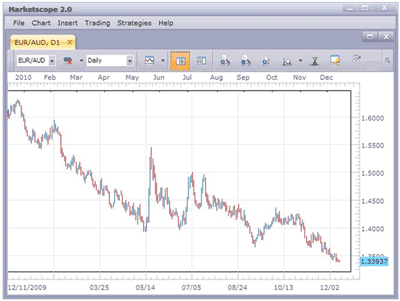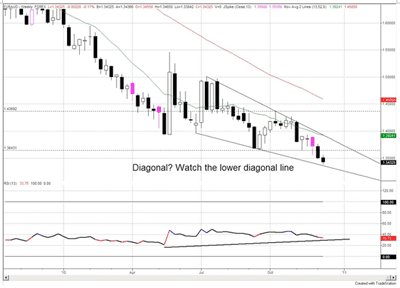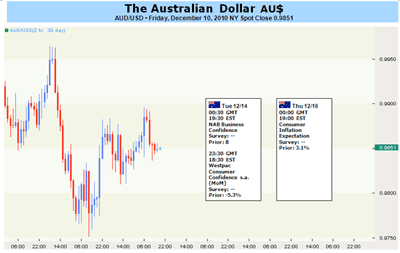Nothing quite signals a strong downtrend like a multi-decade low, which is what the EUR/AUD printed yesterday. The series of lower highs and lower lows continues off of the highs in late 2008. This means to continue to look for selling opportunities to take advantage of this strong move and bias to the downside.
A move above 13650 is needed in order to suggest that a longer-term low is in place. A “harami” candle pattern (current candle body engulfed by previous candle body) combined with a relative strength indicator (RSI) trend line support and RSI divergence on the daily indicate potential for formation of a significant bottom. Watch the lower diagonal line on the weekly for support.
In the meantime, the AUD/USD failed to retrace the sharp decline from the beginning of December, and the high-yielding currency is likely to face increased headwinds going into the following week as market participants speculate China to tighten monetary policy ahead of its inflation report, which is expected to show consumer prices rising at the fastest pace since 2008. The People’s Bank of China announced reserve requirements for commercial banks will increase another 50 basis points beginning December 20 in an attempt to stem the risks for inflation, and the government is likely to take additional steps to cool the marked expansion in economic activity as it aims to encourage a sustainable recovery.
Policymakers in China met over the weekend at the three-day Central Economic Work Conference kicked off on Friday, and the PBoC may look to withdraw monetary support at a rapid pace in an effort to contain the acceleration in price growth. In turn, the Reserve Bank of Australia may retain its wait-and-see approach throughout the beginning of 2011, and hawkish comments from China’s central bank could lead the Australian dollar to extend the decline from earlier this month as the uncertainties clouding the global economic outlook weigh on market sentiment. Last week, the RBA held a neutral tone for future policy and talked down the risks for inflation after keeping the benchmark interest rate at 4.75%, and the central bank may continue to curb speculation for a rate hike in the beginning of the following year as the rise in global trade tapers off. As the head-and-shoulders top in the AUD/USD remains intact, we should see the exchange rate fall back below the neckline around 0.9700 over the near term, and the pair may continue to retrace the rally from earlier this year as we anticipate China to embark on additional monetary tightening over the coming months.
As a result, currency traders may show little reaction to the economic event risks scheduled for the following week as they weigh the prospects for future policy, and the Australian dollar could face increased headwinds going into 2011 as interest rate expectations falter. However, as risk trends continue to dictate price action in the foreign exchange market, a rebound in market sentiment could lead the AUD/USD to consolidate in the week ahead, but the fears surrounding the European debt crisis could lead the flight to safety to gather pace as policymakers struggle to restore investor confidence.
By the Staff at DailyFX.com
DailyFX provides forex news on the economic reports and political events that influence the currency market























